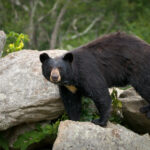The Great Smoky Mountains provide a stunning landscape of alluring dense forest, miles of warm streams, and vast lowlands that make it a must see for nature lovers. It is a unique geographical location and home to rare plant and animal species that people come from far and wide to view and enjoy. The park’s management has done a great job of preserving this delicate habitat for its residents without compromising visitors’ ability to catch a glimpse. If you are at the right place at the right time, you could see some of the rare animals that make the Great Smoky Mountains their home. The following are just some of the animals found here:
Black Bear
It is said that there are so many black bear in this park that you are likely to see two bears in a 2sq mile area. Bears that thrive in this environment can live for 12-15 years, if their habitat is not destroyed by humans. Authorities discourage people from feeding the bear or other wildlife because it makes them lazy and unlikely to hunt for their own food. It is important for humans to keep a safe distance away from any black bear you might encounter because they can be unpredictably aggressive. especially if they have cubs close by.
Salamander
This park is also fondly known as The Salamander Capital of the World in reference to its rich population of the reptile. The Great Smoky is home to five families of salamander, the most popular of which is the Lungless Salamander that roams the wet parts. As its name suggests, this species does not have lungs like its other namesakes and it breathes through the walls of blood vessels in the mouth and body. These creatures are certainly an attraction to many visitors. But if viewing reptiles is not especially your forte, don’t worry as there is much more wildlife to see in the Great Smoky Mountains.
Elk
These animals were once hunted down to extinction, but thanks to considerable efforts to reintroduce them in 2001, they have made a comeback! Park authorities thought it would be wise to bring in 25 new elk to the park in the hope of restoring the once thriving population. Thankfully, after years of long suffering, they were able to survive the wilderness. It might have taken time to adapt but thanks to sheer hard work, visitors to the park can see some of the 100 elk enjoying their natural habitat. Although the original elk introduced to the area lost many cubs to predators, they survived and figured out how to thrive in the mountain environment.
Deer
Once you’ve seen enough elk, you can turn attention to the deer that freely roam the land. White spotted deer are the natives here. If you are lucky, you could view a herd of deer peacefully feasting on the rich, delicious grass and plants. Deer are typically very picky eaters, choosing only the best plants to eat but when times are hard, these mammals can even eat poison ivy.
Snakes
Most people squirm at the thought of snakes freely roaming their surroundings, but if you are in the Great Smoky Mountains you had better brace yourself. Snakes are found in all elevations of the park, but it may be comforting to know that only two of the types that live here are actually venomous. However, always keep your distance and never try to tackle the snakes here, as it could be a timber rattlesnake or the infamous northern copperhead. Unless you are an expert at identifying snakes, it is very possible to get very hurt by the reptiles if they mistake your advances for an attack.
Fish
The park boasts more than 700 miles of beautiful mountain streams, which make an excellent home for many types of fish. Brook trout, Smoky Madtom, Yellow fin madtom and spotfin chub are some of the native species that call this place home. It has taken a great deal of effort to reintroduce some species in the park to ensure that our generation continues to appreciate nature in all its diversity.
Apart from the mammals, reptiles and fish in the park you can also view rare birds like peregrine falcon and red cockaded woodpecker to name a few. If you are lucky, you might even encounter a gray wolf, river otter or the elusive mountain lion, which is seldom seen.
All in all, the Great Smoky Mountains provide a beautiful natural backdrop to see many types of animals in their natural habitat. If you are a wildlife lover, you will certainly enjoy your time spent here! Call now and make your reservation at Creekside Lodge so you can get out and enjoy the beautiful nature and wildlife the Great Smoky Mountains have to offer! Our friendly staff at Creekside Lodge will be happy to help you with any questions you might have! Don’t hesitate because with almost 10 million visitors each year to these mountains, lodging can quickly book up! Call Creekside Lodge at (800) 621-1260 today!













